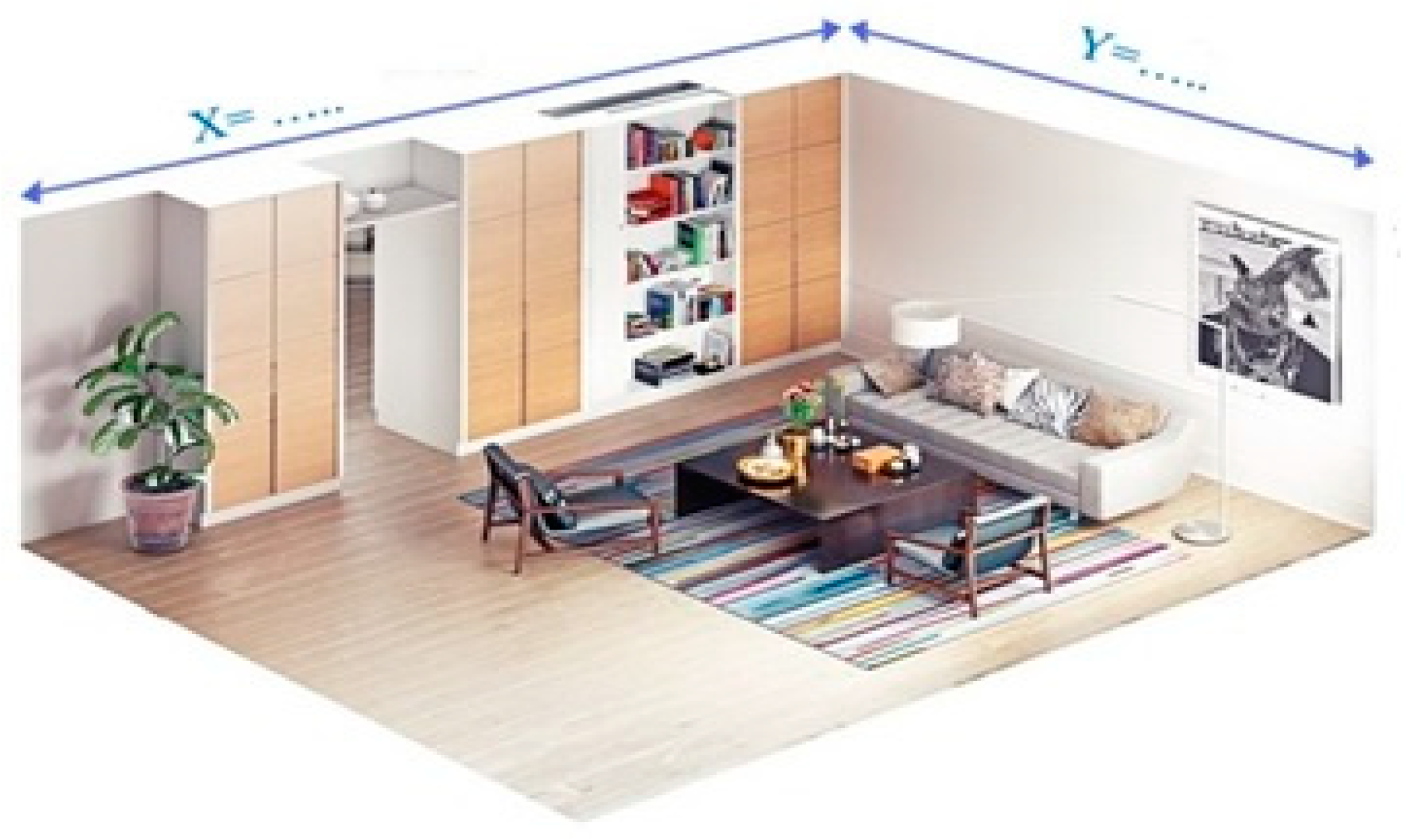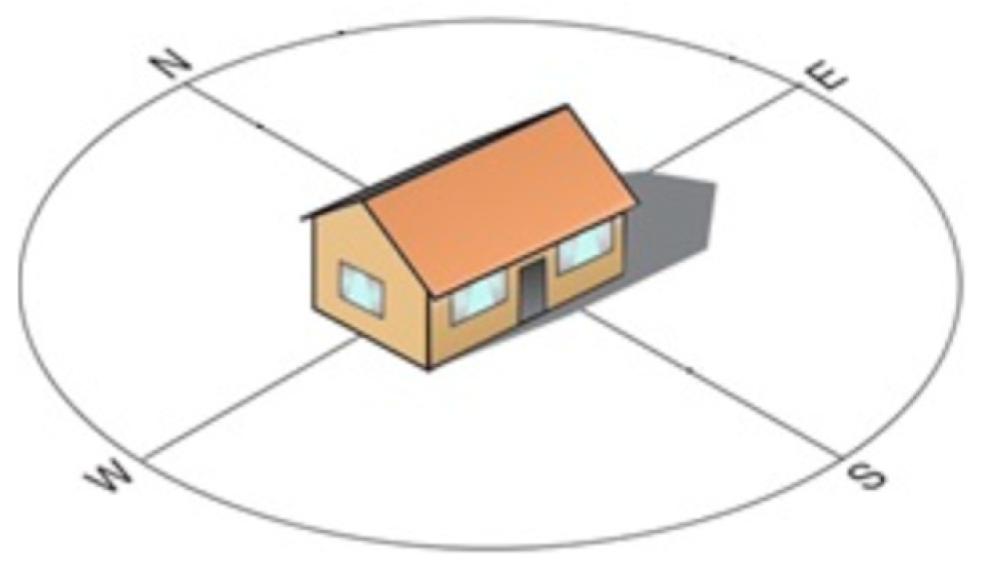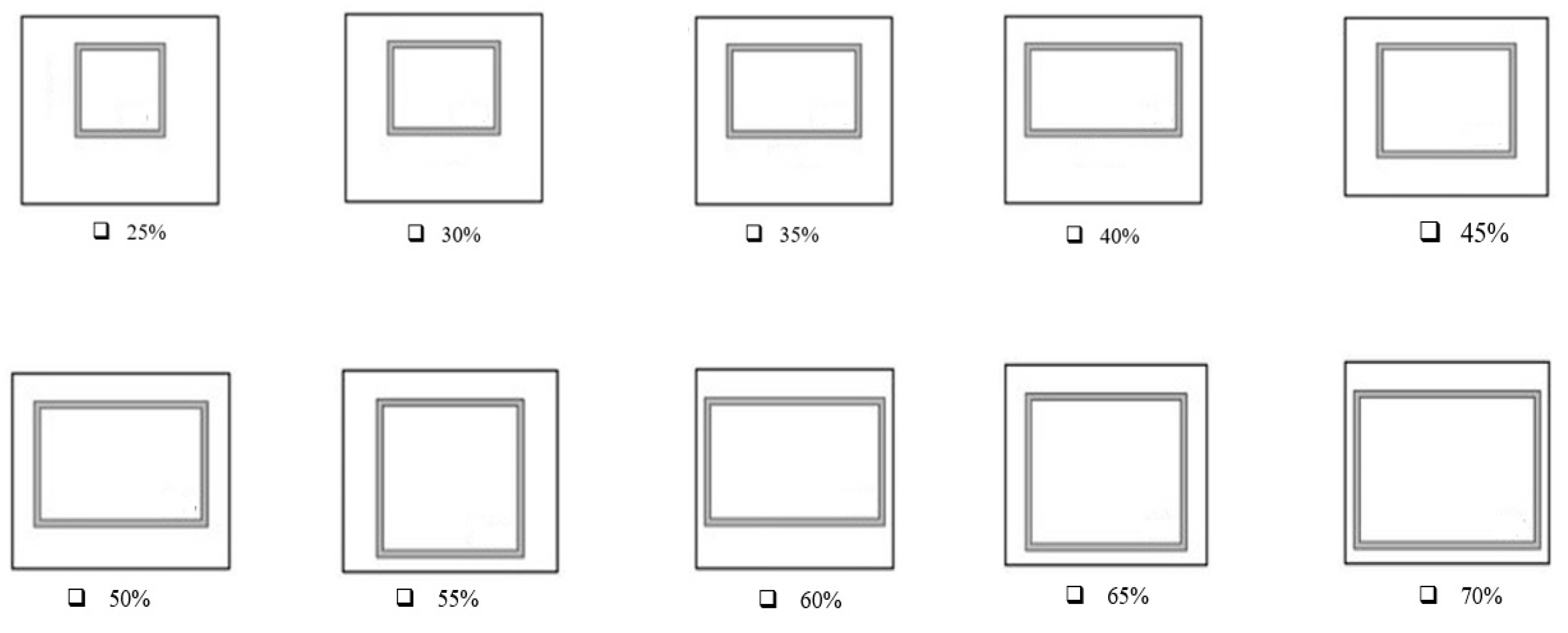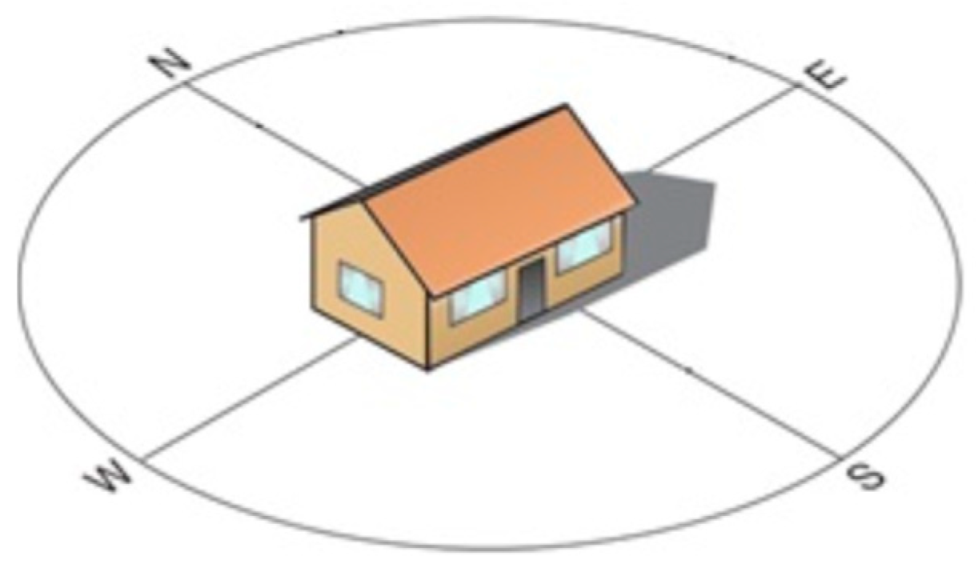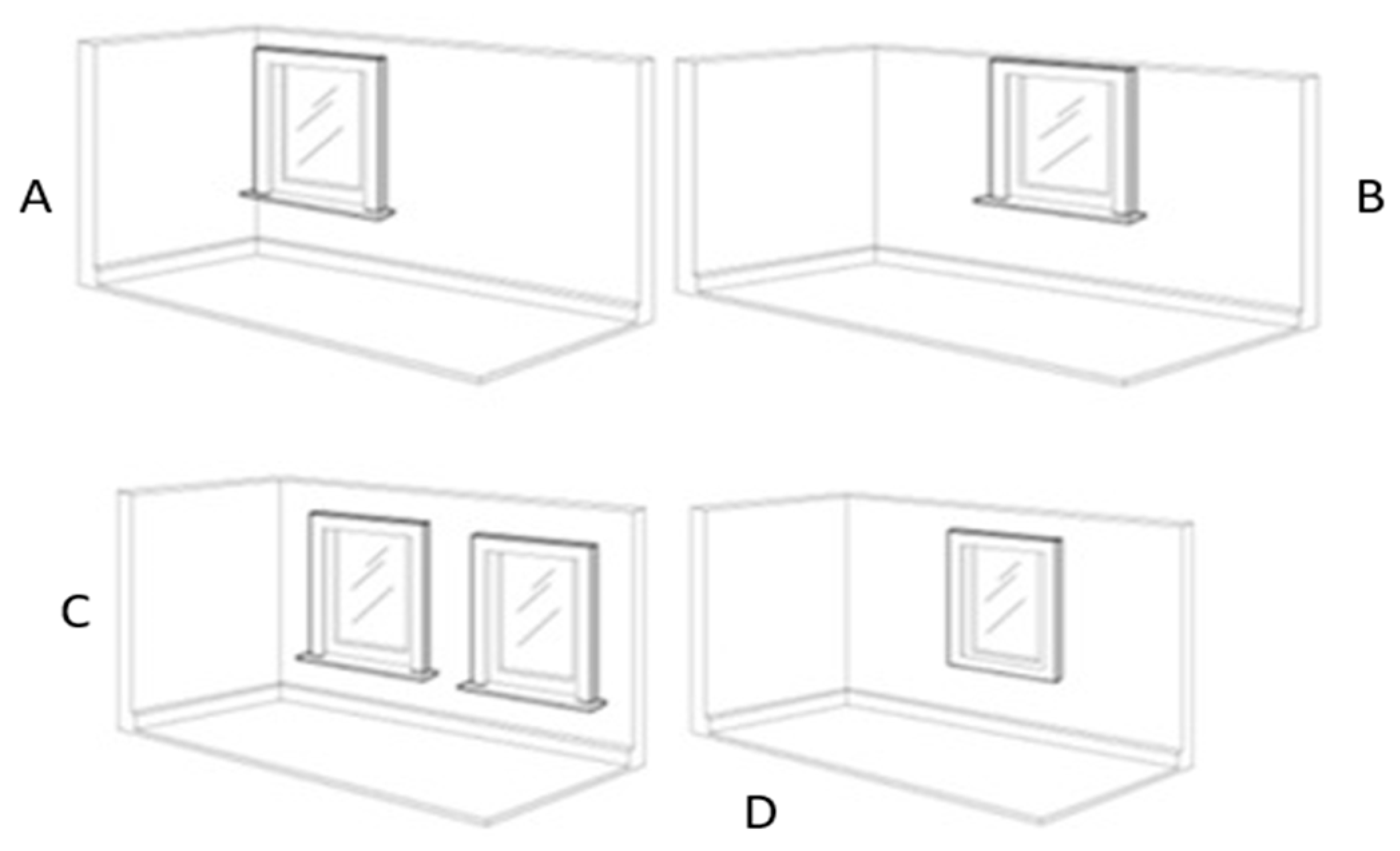Linking Occupant Behavior and Window Design through Post-Occupancy Evaluation: Enhancing Natural Ventilation and Indoor Air Quality
Abstract
1. Introduction
2. Methodology
- How do occupants move through and utilize the building?
- How do they interact with the various systems and features of the building?
- How do their presence and activities affect the overall performance and functionality of the structure?
2.1. Targeted Participants
2.2. Survey Design and Analysis
3. Results and Discussion
3.1. Occupants’ Behavior
- Window orientation and placement that maximizes natural ventilation potential while considering prevailing wind directions;
- Appropriate window-to-wall ratios that balance ventilation requirements; and
- Operable window configurations that allow occupants to control airflow as needed.
- Appropriate window-to-wall ratios and glazing properties that prioritize daylight provision and visual connections;
- Window orientation and placement that enhances access to desirable views; and
- Integration of external shading devices or dynamic glazing to manage glare while maintaining the view.
- Local climatic conditions to identify periods suitable for natural ventilation;
- Building orientation and window placement that enables effective cross-ventilation during favorable conditions; and
- Operable windows that are easily accessible for occupants to take advantage of pleasant outdoor air.
3.2. Occupants’ Behavior and Windows Design Parameters
3.2.1. Window Orientation
3.2.2. Window Placement
3.2.3. Window-to-Wall Ratio (WWR)
4. Limitations and Future Directions
5. Conclusions
Author Contributions
Funding
Data Availability Statement
Acknowledgments
Conflicts of Interest
Appendix A. Questionnaire
- Demographic Factors (DF)
- Please select your gender:
- ○
- Female
- ○
- Male
- ○
- Other
- ○
- I prefer not to answer.
- Please select your age group:
- ○
- 18–25
- ○
- 25–35
- ○
- 35–45
- ○
- 45–55
- ○
- 55 and over
- ○
- I prefer not to answer.
- Your current height and weight (for automatic BMI calculation)?
- ○
- Height ……
- ○
- Weight ……
- ○
- Calculate (BMI)
- What is the best way to describe your residency status?
- ○
- I am an owner-occupier.
- ○
- I am a tenant, and my electricity bill is included in my rent.
- ○
- I am a tenant, and my electricity bill is not included in my rent.
- ○
- I am a subtenant, and my electricity bill is included in my rent.
- ○
- I am a subtenant, and my electricity bill is not included in my rent.
- ○
- I prefer not to answer.
- ○
- Please specify if other
- Based on the below scale (0–100), rate the importance of each of these factors when controlling your indoor environment:
- What is the total income of your family after taxes are deducted?
- ○
- Less than 45.000
- ○
- 45.000 to 89.000
- ○
- 89.000 to 120.000
- ○
- 120.000 to 180.000
- ○
- More than 180.000
- Geometric and Building Features
- What is your postcode: ….
- What is the height of the ceiling in your house?
- ○
- 2.4–2.5 m
- ○
- 2.5–2.7 m
- ○
- 2.7–3.0 m
- ○
- More than 3.0 m
- ○
- I don’t know.
- The following image shows an example of how to measure a living room. What are the approximate dimensions of your living room?
- X: …. Y: ….
- What kind of residence do you live in?
- ○
- Apartment or Unit
- ○
- House
- ○
- Townhouse
- ○
- Villa
- ○
- Retirement Living
- ○
- Other (i.e., Block of Units, Acreage, Rural, etc.)
- What is the number of occupants in your home?
- ○
- 1
- ○
- 2
- ○
- 3
- ○
- 4
- ○
- 5 or more
- What is the number of rooms in your house?
- ○
- 1
- ○
- 2
- ○
- 3
- ○
- 4
- ○
- 5 or more
- How many square meters (m2) is the approximate area of your residence?The internal areas of the house include the living rooms, bedrooms, and laundry room, but do not include the garage, the outdoor veranda, etc. (see the example image below).
- Residence area is …. m2
- What is the orientation (direction) and size of the windows in your living room?For example, Window 1: N—35%Below is an example image showing the orientation and overall size estimate.
- ○
- Window 1
- ○
- Window 2
- ○
- Window 3
- ○
- Window 4
- ○
- Window 5
- ○
- Window 6
- Which photo best depicts the placement of the windows on the walls? For reference, please see the image below.
- North Wall
- South Wall
- East Wall
- West Wall
- During these periods, where do you usually spend your time?
- ○
- From 8 am to 1 pm
Living Room
Bedroom
Kitchen
- ○
- From 1 pm to 7 pm
Living Room
Bedroom
Kitchen
- ○
- From 7 pm to 12 pm
Living Room
Bedroom
Kitchen
- Behavior and Awareness
- How satisfied are you with your building’s energy expenditures/costs?
- ○
- Very satisfied
- ○
- Satisfied
- ○
- Neutral
- ○
- Dissatisfied
- ○
- Very dissatisfied
- If you were to improve your house’s natural ventilation (save energy), which of the following solutions would you choose?
- ○
- Make your living room more comfortable by installing a fan (if it does not have one already).
- ○
- Customize window sizes.
- ○
- Change the balcony windows (if applicable).
- ○
- Change the ceiling height.
- In terms of natural ventilation, which one is your favorite?
- ○
- Big operable windows
- ○
- Balcony
- What is the most common adaptive behavior you use to make yourself comfortable?
- ○
- Opening/closing window
- ○
- Turning on/off the heater or cooler when feeling too hot/cold
- ○
- Suitable dress based on thermal perception (comfort)
- ○
- Other (shower, drink, swim, etc.)
- ○
- Window blinds or shades
- ○
- Air-conditioning
- ○
- Ceiling fan
- What is your preference?
- ○
- I prefer windows to be closed most of the time.
- ○
- I prefer to change the status of the windows frequently.
- ○
- I prefer to open my windows most of the time.
- When it comes to saving energy, what is the extent to which you are willing to [not] use windows? Scale (0–10) ….
- You will be more comfortable when the environment of your house is…
- Temperature: ο Colder ο A bit colder ο Same ο A bit hotter ο Hotter
- Breeze (indoor air movement): ο Slower ο A bit lower ο Same ο A bit higher ο Higher
- Humidity: ο Drier ο A bit drier ο Same ο A bit wetter ο Wetter
- What is your typical experience with the breeze airflow (air movement) in your home?
- ○
- Completely not acceptable
- ○
- Not acceptable
- ○
- Slightly not acceptable
- ○
- Slightly acceptable
- ○
- Acceptable
- ○
- Perfectly acceptable
- Based on the time of day, you open and close your windows mostly for…… (multi-choice accepted)
- Opening
- ○
- Fresh air
- ○
- For light and view
- ○
- As a habit
- ○
- When indoors is uncomfortable
- ○
- When outdoors is comfortable
- Closing
- ○
- As a habit
- ○
- Due to dust
- ○
- Due to insect
- ○
- During my absence
- ○
- For privacy
- ○
- When outdoors is hot
- In your living room, which one do you have?ο Window ο AC ο Fan ο All
- In your living room, which one do you prefer?ο Window ο AC ο Fan ο All
- Which of the following best describes how you operate your windows?
- Opening:
- ○
- Open as long as possible when no other trigger affects the status.
- ○
- Open when feeling stuffy.
- ○
- Open after getting up in the morning.
- Closing:
- ○
- Never close if no other trigger affects the open status.
- ○
- Close before sleeping.
- ○
- Close before leaving.
- How much is your monthly electricity bill? ………
- How do you use AC in your house’s living room?
- ○
- Comfortable based
- ○
- Schedule based
- ○
- Mixed
- Ventilation Options (VO)
- Heating system
- ○
- Centralized
- ○
- Autonomous
- Heat source type
- ○
- Traditional boiler
- ○
- Condensing boiler
- ○
- Heat pump
- Cooling system
- ○
- Electric air conditioner
- ○
- Fans
- What is the most common type of energy used in your home? (one option or more)
- ○
- Electricity
- ○
- Gas
- ○
- Solar
- ○
- Other (i.e., coal, wood, LPG, Paraffin, etc.)
- Thermal and Overall Comfort (C)
- What is the main reason you [if] feel uncomfortable about Indoor Air Quality?
- ○
- Stuffy air
- ○
- Bad/strong offensive odors
- ○
- Outdoor air
- ○
- Relative humidity
- ○
- N/A
- During hot weather, how do you feel if one of the following cooling devices or strategies is your only option for cooling? (please select the relevant option)
- (a)
- Airstream (AS) via openable balconies’ doors
COLD Cool Slightly Cool Neutral Slightly Warm Warm Hot I Don’t Use - (b)
- Airstream (AS) via openable windows’ doors
COLD Cool Slightly Cool Neutral Slightly Warm Warm Hot I Don’t Use - (c)
- Ceiling Fan
COLD Cool Slightly Cool Neutral Slightly Warm Warm Hot I Don’t Use - (d)
- Combination of Fan and AS
COLD Cool Slightly Cool Neutral Slightly Warm Warm Hot I Don’t Use - (e)
- Air-conditioning (AC)
COLD Cool Slightly Cool Neutral Slightly Warm Warm Hot I Don’t Use - (f)
- Combination of AC and air stream
COLD Cool Slightly Cool Neutral Slightly Warm Warm Hot I Don’t Use
Appendix B. Occupants’ Behavior Analysis Questions
- Which of the following solutions would you prefer to do to have better natural ventilation (saving energy) in your house?
- Make your living room more comfortable by installing a fan (if it does not have one already).
- Customize window sizes.
- Change the balcony windows (if applicable).
- Change the ceiling height.
- Which one do you prefer to have by natural ventilation?
- Big operable windows
- Balcony
- Which of these adaptive behaviors do you usually use to make yourself comfortable?
- Opening/closing window.
- Turning on/off the heater or cooler when feeling too hot/cold.
- Suitable dress based on thermal perception (comfort).
- Other (shower, drink, swim, etc.).
- Window blinds or shades.
- Air-conditioning.
- Ceiling fan.
- How would you describe your preference?
- Prefer windows to be closed most of the time.
- Prefer to change the windows’ status frequently.
- Prefer to open windows most of the time.
- Your window opening activity according to the time of the day is mostly for… (multi-choice accepted)
- Fresh air.
- For light and view.
- As a habit.
- When indoors is uncomfortable.
- When outdoors is comfortable.
- Your window closing activity according to the time of the day is mostly for… (multi-choice accepted)
- As a habit.
- Due to dust.
- Due to insect.
- During my absence.
- For privacy.
- When the outdoors is hot.
- Which one do you have in your living room?A. Window B. AC C. Fan D. All
- Which one do you prefer to use in your living room:A. Window B. AC C. Fan D. All
- Which one best describes your window opening operation model?
- Open as long as possible when no other trigger affects the status.
- Open when feeling stuffy.
- Open after getting up in the morning.
- Which one best describes your window closing operation model?
- Never close if no other trigger affects the open status.
- Close before sleeping.
- Close before leaving.
References
- Jackson, R.B.; Le Quéré, C.; Andrew, R.M.; Canadell, J.G.; Korsbakken, J.I.; Liu, Z.; Peters, G.P.; Zheng, B. Global energy growth is outpacing decarbonization. Environ. Res. Lett. 2018, 13, 120401. [Google Scholar] [CrossRef]
- 2020 Global Status Report for Buildings and Construction|Globalabc. 16 December 2020. Available online: https://globalabc.org/resources/publications/2020-global-status-report-buildings-and-construction (accessed on 29 May 2024).
- International Energy Agency. Buildings. Available online: https://www.iea.org/energy-system/buildings (accessed on 29 May 2024).
- United Nations Environment Programme. CO2 Emissions from Buildings and Construction Hit New High, Leaving Sector off Track to Decarbonize by 2050: UN. 9 November 2022. Available online: https://www.unep.org/news-and-stories/press-release/co2-emissions-buildings-and-construction-hit-new-high-leaving-sector (accessed on 29 May 2024).
- Yan, Y.; Song, C.; Pan, W.; Wang, J.; Bai, Y. Analysis of Resistance Characteristics and Research into Resistance Reduction of a Tee Based on Field Synergy. Buildings 2024, 14, 1271. [Google Scholar] [CrossRef]
- IEA. Energy Statistics Data Browser—Data Tools. Available online: https://www.iea.org/data-and-statistics/data-tools/energy-statistics-data-browser?country=WORLD&fuel=Energy%20consumption&indicator=ElecConsBySector (accessed on 29 May 2024).
- Wingrove, K.; Heffernan, E.; Daly, D. Increased home energy use: Unintended outcomes of energy efficiency focused policy. Build. Res. Inf. 2024, 1–19. [Google Scholar] [CrossRef]
- NatHERS News—Tuesday 19 March|Nationwide House Energy Rating Scheme (NatHERS). 20 March 2024. Available online: https://www.nathers.gov.au/blog/nathers-news-tuesday-19-march (accessed on 29 May 2024).
- Li, J.; Iulo, L.; Poerschke, U. A review of the energy performance gap between predicted and actual use in buildings. Build. Simul. Conf. Proc. 2023, 18, 3406–3413. [Google Scholar] [CrossRef]
- Zheng, Z.; Zhou, J.; Zhu Jiaqin Yang, Y.; Xu, F.; Liu, H. Review of the building energy performance gap from simulation and building lifecycle perspectives: Magnitude, causes and solutions. Dev. Built Environ. 2024, 17, 100345. [Google Scholar] [CrossRef]
- Van Dronkelaar, C.; Dowson, M.; Burman, E.; Spataru, C.; Mumovic, D. A review of the energy performance gap and its underlying causes in non-domestic buildings. Front. Mech. Eng. 2016, 1, 17. [Google Scholar] [CrossRef]
- Zou, P.X.; Wagle, D.; Alam, M. Strategies for minimizing building energy performance gaps between the design intent and the reality. Energy Build. 2019, 191, 45–55. [Google Scholar] [CrossRef]
- Rusek, R.; Frigola, J.M.; Llinas, J.C. Influence of occupant presence patterns on energy consumption and its relation to comfort: A case study based on sensor and crowd-sensed data. Energy Sustain. Soc. 2022, 12, 13. [Google Scholar] [CrossRef]
- Delzendeh, E.; Wu, S.; Lee, A.; Zhou, Y. The impact of occupants’ behaviours on building energy analysis: A research review. Renew. Sustain. Energy Rev. 2017, 80, 1061–1071. [Google Scholar] [CrossRef]
- Pathirana, S.; Rodrigo, A.; Halwatura, R. Effect of building shape, orientation, window-to-wall ratios and zones on energy efficiency and thermal comfort of naturally ventilated houses in tropical climate. Int. J. Energy Environ. Eng. 2019, 10, 107–120. [Google Scholar] [CrossRef]
- Chou, Y.-A.; Wang, Z.-Y.; Chang, H.-C.; Liu, Y.-C.; Su, P.-F.; Yen Ta Huang Yang, C.-T.; Lai, C.-H. Indoor CO2 monitoring in a surgical intensive care unit under visitation restrictions during the COVID-19 pandemic. Front. Med. 2023, 10, 1052452. [Google Scholar] [CrossRef]
- Yoo, J.; Cho, G.Y. Effect of Occupants’ Window Opening Behavior and Annual Ventilation Rates in Residential Building. J. Korean Sol. Energy Soc. 2020, 40, 69–76. [Google Scholar] [CrossRef]
- Yoo, J.; Kim, S.; Qi, L.; Choi, S.; Bae, J.; Park, J. An Analysis of Natural Ventilation and Ventilation load in relation to Occupants’ window opening Behaviour in residential Building. E3S Web Conf. 2022, 356, 03054. [Google Scholar] [CrossRef]
- Eichholtz, P.; Kok, N.; Sun, X. The effect of post-COVID-19 ventilation measures on indoor air quality in primary schools. PNAS Nexus 2023, 3, pgad429. [Google Scholar] [CrossRef]
- Akhlaghinezhad, F.; Tabadkani, A.; Bagheri Sabzevar, H.; Seyed Shafavi, N.; Nikkhah Dehnavi, A. Deterministic and probabilistic occupant-centric control’s impacts on the indoor environment in free-running households. Smart Sustain. Built Environ. 2024. ahead-of-print. [Google Scholar] [CrossRef]
- Pandey, P.; Dong, B. Analysis of Impacts of Window Opening Behavior on Indoor Air Pollutants in Residential Dorms through Deep Neural Network. E3S Web Conf. 2023, 396, 01097. [Google Scholar] [CrossRef]
- Scislo, L.; Szczepanik-Scislo, N. Near Real-Time Access Monitoring Based on IoT Dynamic Measurements of Indoor Air Pollutant. In Proceedings of the 2023 IEEE 12th International Conference on Intelligent Data Acquisition and Advanced Computing Systems: Technology and Applications (IDAACS), Dortmund, Germany, 7–9 September 2023; pp. 729–734. [Google Scholar] [CrossRef]
- Ekim, Z.E.; Mattsson, P.; Bernardo, R. Assessments of users’ interactions with energy-efficient solutions: A systematic review. Build. Environ. 2023, 242, 110522. [Google Scholar] [CrossRef]
- Alwedyan, S. Electricity energy-saving behavior of households in Jordan: A qualitative study. Manag. Environ. Qual. 2024. [Google Scholar] [CrossRef]
- Umoh, A.A.; Adefemi, A.; Ibewe, K.I.; Etukudoh, E.A.; Ilojianya, V.I.; Nwokediegwu, Z.Q.S. Green Architecture and Energy Efficiency: A Review of Innovative Design and Construction Techniques. Eng. Sci. Technol. J. 2024, 5, 185–200. [Google Scholar] [CrossRef]
- Hu, S.; Zhou, X.; Yan, D.; Guo, F.; Hong, T.; Jiang, Y. A systematic review of building energy sufficiency towards energy and climate targets. Renew. Sustain. Energy Rev. 2023, 181, 113316. [Google Scholar] [CrossRef]
- Okpalike, C.; Okeke, F.O.; Ezema, E.C.; Oforji, P.I.; Igwe, A.E. Effects of Renovation on Ventilation and Energy Saving in Residential Building. Civ. Eng. J. 2022, 7, 124–134. [Google Scholar] [CrossRef]
- Abdullah, H.K. Window Design and Natural Ventilation Relationship in Terms of Reducing Carbon Dioxide and Improving Thermal Comfort. 2021. Available online: http://hdl.handle.net/11129/5691 (accessed on 29 May 2024).
- Zhao, J.; Yang, L.; Ren, H. Study on Spatial and Temporal Distribution Characteristics of PM2.5 in the Main Urban Area of Nanjing and Influencing Factors. IOP Conf. Ser. Earth Environ. Sci. 2022, 973, 012001. [Google Scholar] [CrossRef]
- Jeong, B.; Choi, H.; Park, J. Predicting window opening behaviour of individual occupants using machine learning models. In Proceedings of the 15th Conference of the International Society of Indoor Air Quality and Climate, INDOOR AIR 2018, Virtual, 3 December 2021. [Google Scholar]
- Zhang, W.; Calautit, J. Occupancy behaviour and patterns: Impact on energy consumption of high-rise households in southeast China. Smart Energy 2022, 6, 100072. [Google Scholar] [CrossRef]
- Sibilla, M.; Kurul, E. Transdisciplinarity in energy retrofit. A Conceptual Framework. J. Clean. Prod. 2020, 250, 119461. [Google Scholar] [CrossRef]
- Reis, D.C.; De Domenico, A.T.; Lopes, L.; Almeida, M. Strategies and Actions for Achieving Carbon Neutrality in Portuguese Residential Buildings by 2050. Sustainability 2023, 15, 15626. [Google Scholar] [CrossRef]
- Ko, W.H.; Schiavon, S.; Santos, L.; Kent, M.G.; Kim, H.; Keshavarzi, M. View access index: The effects of geometric variables of window views on occupants’ satisfaction. Build. Environ. 2023, 234, 110132. [Google Scholar] [CrossRef]
- Ran, J.; Xiong, K.; Dou, M.; Zhong, H.; Feng, Y.; Tang, M.; Yang, Z. Effect of Window Openable Area and Shading on Indoor Thermal Comfort and Energy Efficiency in Residential Buildings with Various Operating Modes. Atmosphere 2022, 13, 723. [Google Scholar] [CrossRef]
- Miroslav, P.; Maja, Z.; Leskovar, Z. Influence of the building shape on the energy performance of timber-glass buildings located in warm climatic regions. J. Energy 2018, 149, 496–504. [Google Scholar] [CrossRef]
- Asif, A.; Zeeshan, M.; Khan, S.R.; Sohail, N.F. Investigating the gender differences in indoor thermal comfort perception for summer and winter seasons and comparison of comfort temperature prediction methods. J. Therm. Biol. 2022, 110, 103357. [Google Scholar] [CrossRef]
- Indraganti, M.; Humphreys, M.A. A comparative study of gender differences in thermal comfort and environmental satisfaction in air-conditioned offices in Qatar, India, and Japan. Build. Environ. 2021, 206, 108297. [Google Scholar] [CrossRef]
- Abd-Alhamid, F.; Kent, M.; Wu, Y. Quantifying window view quality: A review on view perception assessment and representation methods. Build. Environ. 2023, 227, 109742. [Google Scholar] [CrossRef]
- Andersen, R.V.; Toftum, J.; Andersen, K.K.; Olesen, B.W. Survey of occupant behaviour and control of indoor environment in Danish dwellings. Energy Build. 2009, 41, 11–16. [Google Scholar] [CrossRef]
- Hao, M.; Hejiang, S.; Junjie, L.; Shen, W. Developing window behaviour model for residential buildings using XGBoost algorithm. Energy Build. 2019, 205, 109564. [Google Scholar] [CrossRef]
- Morrison, G.; Cagle, J.; Date, G. A national survey of window-opening behaviour in United States homes. Indoor Air 2021, 32, e12932. [Google Scholar] [CrossRef]
- Sabet, P.; Ciampi, G.; Scorpio, M.; Sibilio, S. A preliminary review of case studies window view quality in building. AIP Conf. Proc. 2023, 2928, 060003. [Google Scholar] [CrossRef]
- Nazmy, H.; Kim, S.K.; Lee, E. Spatial Factors Related to Occupants’ Behavioral Beliefs about Window and Blind Use in Multifamily Residential Buildings. Environ. Behav. 2023, 55, 236–277. [Google Scholar] [CrossRef]
- Harputlugil, G.U. Re-Thinking of Energy Consumption Classification by the Patterns of Occupant Behaviour in Dwellings: A Conceptual Framework. Semantic Scholar. 2016. Available online: https://www.semanticscholar.org/paper/Re-thinking-of-energy-consumption-classification-by-Harputlugil/254f8263c7e7a621a8231338117ab3cf9c661a8f (accessed on 29 May 2024).
- Ebuy, H.T.; Bril El Haouzi, H.; Benelmir, R.; Pannequin, R. Occupant Behavior Impact on Building Sustainability Performance: A Literature Review. Sustainability 2023, 15, 2440. [Google Scholar] [CrossRef]
- Liu, L.; Sun, C.; Liu, Y.; Leng, H.; Yang, Y. Optimized design research on daylighting performance of cold land buildings based on improved neural network. Appl. Math. Nonlinear Sci. 2024, 9, 1–16. [Google Scholar] [CrossRef]
- Cheng, K.; Yao, J.; Zheng, R. Energy Performance of Occupant Behaviors on Windows: A Green Building Based Study. Energies 2023, 16, 2209. [Google Scholar] [CrossRef]
- Occupant Behavior in Buildings|Building Technology and Urban Systems. Available online: https://buildings.lbl.gov/news/occupant-behavior-buildings (accessed on 28 April 2024).
- Tang, R.; Wang, S.; Sun, S. Impacts of technology-guided occupant behavior on air-conditioning system control and building energy use. Build. Simul. 2021, 14, 209–217. [Google Scholar] [CrossRef]
- Calì, D.; Andersen, R.K..; Osterhage, T.; Wesseling, M.; Müller, D.; Olesen, B.W. Analysis of the Occupants’ Behavior Related to Natural Ventilation: 12th REHVA World Congress. CLIMA 2016—Proceedings of the 12th REHVA World Congress. 2016; Volume 10. Available online: https://orbit.dtu.dk/en/publications/analysis-of-the-occupants-behavior-related-to-natural-ventilation (accessed on 29 May 2024).
- Ajirlou, I.F.; Kurtay, C. Assessing the performance of the airflow window for ventilation and thermal comfort in office rooms. Arch. Thermodyn. 2021, 42, 209–242. [Google Scholar] [CrossRef]
- Wang, L. Window Operation and Its Impacts on Thermal Comfort and Energy Use; Lecture Notes in Electrical Engineering; Springer: Berlin/Heidelberg, Germany, 2013; pp. 259–266. [Google Scholar] [CrossRef]
- Grygierek, K.; Nateghi, S.; Ferdyn-Grygierek, J.; Kaczmarczyk, J. Controlling and Limiting Infection Risk, Thermal Discomfort, and Low Indoor Air Quality in a Classroom through Natural Ventilation Controlled by Smart Windows. Energies 2023, 16, 592. [Google Scholar] [CrossRef]
- Zheng, C.; Xu, W.; Wang, L.; Cao, X.; Li, M.; Zhang, A. Multi-objective optimization of energy, thermal and visual comfort for dormitory buildings in the cold climate of China. Indoor Built Environ. 2023, 33, 250–268. [Google Scholar] [CrossRef]
- Altun, A.F.; Kiliç, M. Influence of Window Parameters on the Thermal Performance of Office Rooms in Different Climate Zones of Turkey. Int. J. Renew. Energy Res. 2019, 9, 226–243. [Google Scholar] [CrossRef]
- Kaminska, A. Impact of Heating Control Strategy and Occupant Behavior on the Energy Consumption in a Building with Natural Ventilation in Poland. Energies 2019, 12, 4304. [Google Scholar] [CrossRef]
- Awadh, O.; Abu-Hijleh, B. The Impact of External Shading and Windows’ Glazing and Frame on Thermal Performance of Residential House in Abu-Dhabi. 2013. Available online: https://bspace.buid.ac.ae/buid_server/api/core/bitstreams/4190a394-f869-45f1-86fc-11d6e4e9baa0/content (accessed on 29 May 2024).
- Wellington, D.; Aigbavboa, C. Performance of a Green Building’s Indoor Environmental Quality on Building Occupants in South Africa. Ssrn.com. 7 February 2019. Available online: https://papers.ssrn.com/sol3/papers.cfm?abstract_id=3538775 (accessed on 29 May 2024).
- Switchable Windows Demonstrated to Provide Increased View in Offices Transparent Electrochromic Windows Increase User Options for Tuning Their Environment to Satisfy Personal Preferences for Daylight, View, and Comfort. Available online: https://task61.iea-shc.org/Data/Sites/1/publications/US-Portland-EC-Glazing.pdf (accessed on 29 May 2024).
- Yang, Q.; Li, N. Subjective and Objective Evaluation of Shading on Thermal, Visual, and Acoustic Properties of Indoor Environments. Sustainability 2022, 14, 11776. [Google Scholar] [CrossRef]
- Zhang, Y.; Li, X.; Cheng, P. Optimal Window Opening Based on Natural Ventilation Measurements. Available online: https://www.aivc.org/sites/default/files/58_0.pdf (accessed on 12 May 2024).
- Cheung, T.; Tham, K.W. Effects of ceiling fan and window exhaust on aerosol transmission risk during home quarantine situation. E3S Web Conf. 2023, 396, 02006. [Google Scholar] [CrossRef]
- Badeche, M.; Benkhalifa, A.E.-S. Analysis of the Users’ Perception of Daylighting in Newly Libraries of Algeria. Int. J. Innov. Stud. Sociol. Humanit. 2022, 7, 118–124. [Google Scholar] [CrossRef]
- Trudeau, M.; Li, C.; Frisque, A. Modelling for Daylight Autonomy for LEED v4—Implications for Cities in Northern Latitudes. Available online: https://publications.ibpsa.org/proceedings/esim/2016/papers/esim2016_74-136.pdf (accessed on 12 May 2024).
- Cheng, S. UC Berkeley Building Efficiency and Sustainability in the Tropics (SinBerBEST) Title Performance-Based Assessment of Daylight on Tropical Buildings—A Case Study Author Publication Date. 2013. Available online: https://escholarship.org/content/qt7j61722z/qt7j61722z.pdf (accessed on 29 May 2024).
- Mori, H.; Kubota, T.; Antaryama, G.N.; Ekasiwi, S.N. Analysis of Window-Opening Patterns and Air Conditioning Usage of Urban Residence in Tropical Southeast Asia. Sustainability 2020, 12, 10443. [Google Scholar] [CrossRef]
- Jiang, S. Measuring the Impact of Occupant Behaviour on Energy Usage in Existing Homes. Doctoral Dissertation, Cardiff University, Cardiff, UK, 2015. [Google Scholar]
- Karjalainen, S. Gender differences in thermal comfort and use of thermostats in everyday thermal environments. Build. Environ. 2007, 42, 1594–1603. [Google Scholar] [CrossRef]
- Turner, W.; Hong, T. A Technical Framework to Describe Occupant Behaviour for Building Energy Simulation; Berkeley National Laboratory: Berkeley, CA, USA, 2014. [Google Scholar]
- Veillette, D.; Rouleau, J.; Gosselin, L. Impact of Window-to-Wall Ratio on Heating Demand and Thermal Comfort When Considering a Variety of Occupant Behaviour Profiles. Sustain. Cities 2021, 3, 700794. [Google Scholar] [CrossRef]
- Khorasani, Z.; Ouf, M. A simulation-based framework to optimize occupant-centric controls given stochastic occupant behaviour. Build. Environ. 2022, 219, 109144. [Google Scholar] [CrossRef]
- Ren, X.; Zhao, Y.; Zeiler, W.; Boxem, G.; Li, T. A Data Mining Approach to Analyse Occupant Behaviour Motivation. Procedia Eng. 2017, 205, 2442–2448. [Google Scholar] [CrossRef]
- Pérez-Navarro, J.; Bueso, M.C.; Vázquez, G. Drivers of and Barriers to Energy Renovation in Residential Buildings in Spain—The Challenge of Next Generation EU Funds for Existing Buildings. Buildings 2023, 13, 1817. [Google Scholar] [CrossRef]
- Azizi, S.; Nair, G.; Olofsson, T. Adoption of Energy Efficiency Measures in Renovation of Single-Family Houses: A Comparative Approach. Energies 2020, 13, 6042. [Google Scholar] [CrossRef]
- Schober, P.; Boer, C.; Schwarte, L.A. Correlation coefficients: Appropriate Use and Interpretation. Anesth. Analg. 2018, 126, 1763–1768. [Google Scholar] [CrossRef]


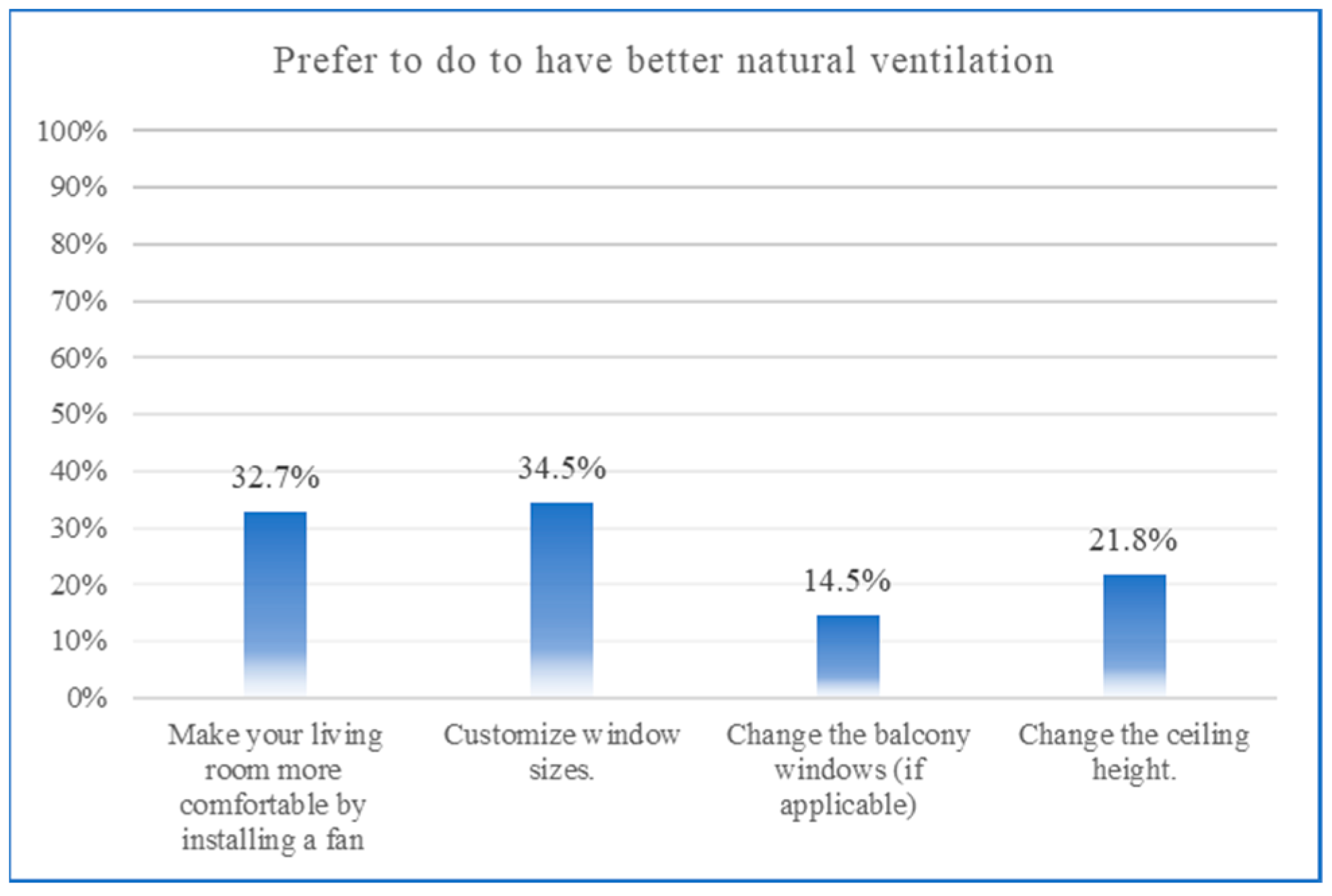
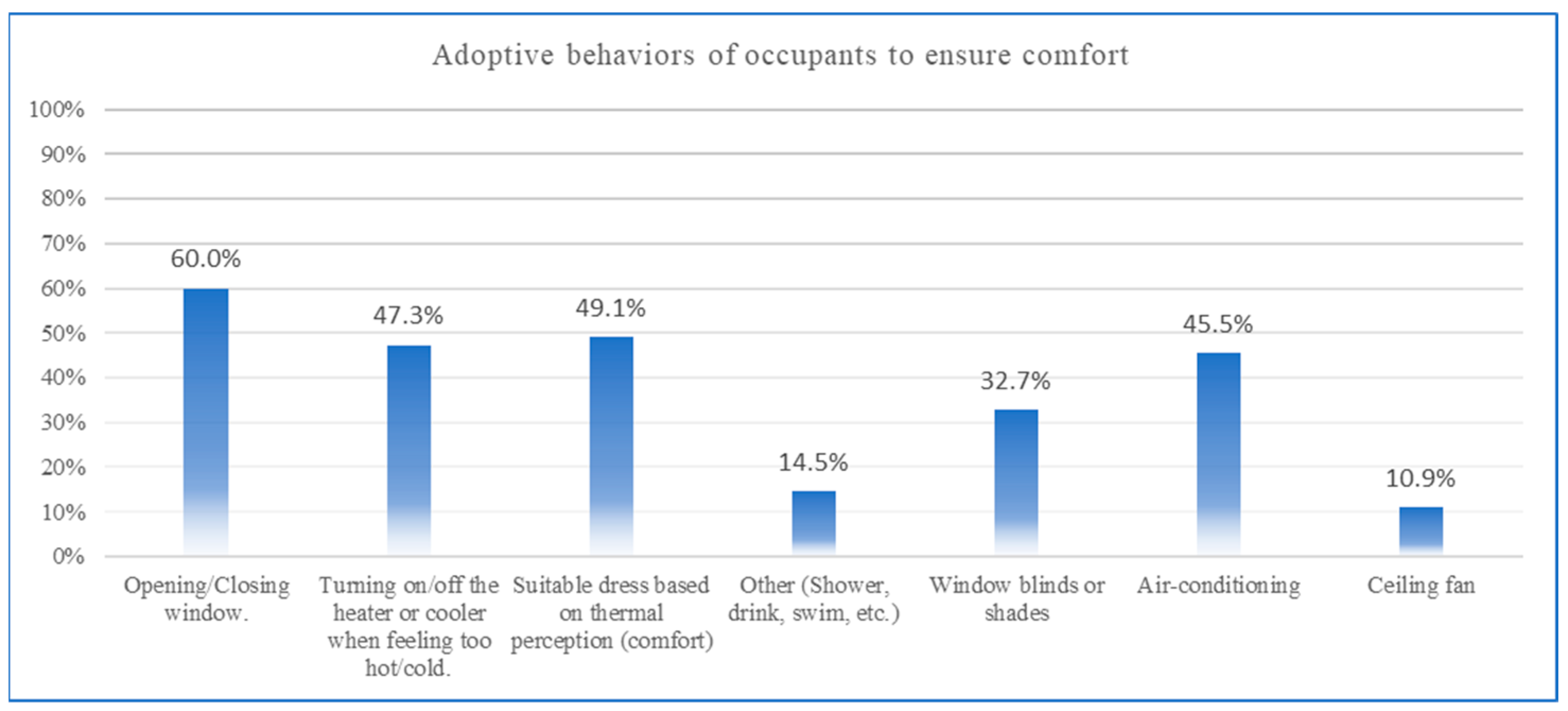
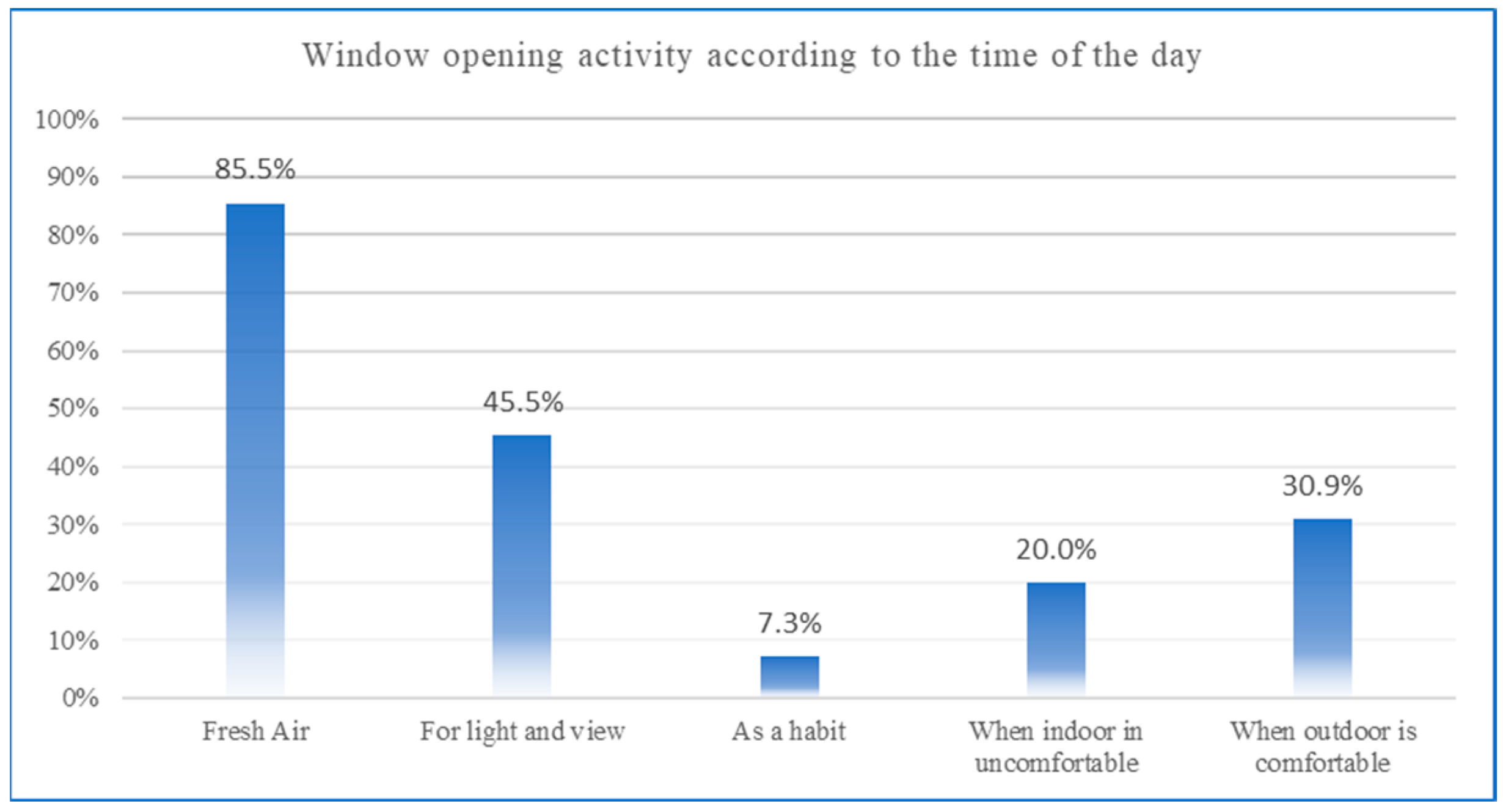
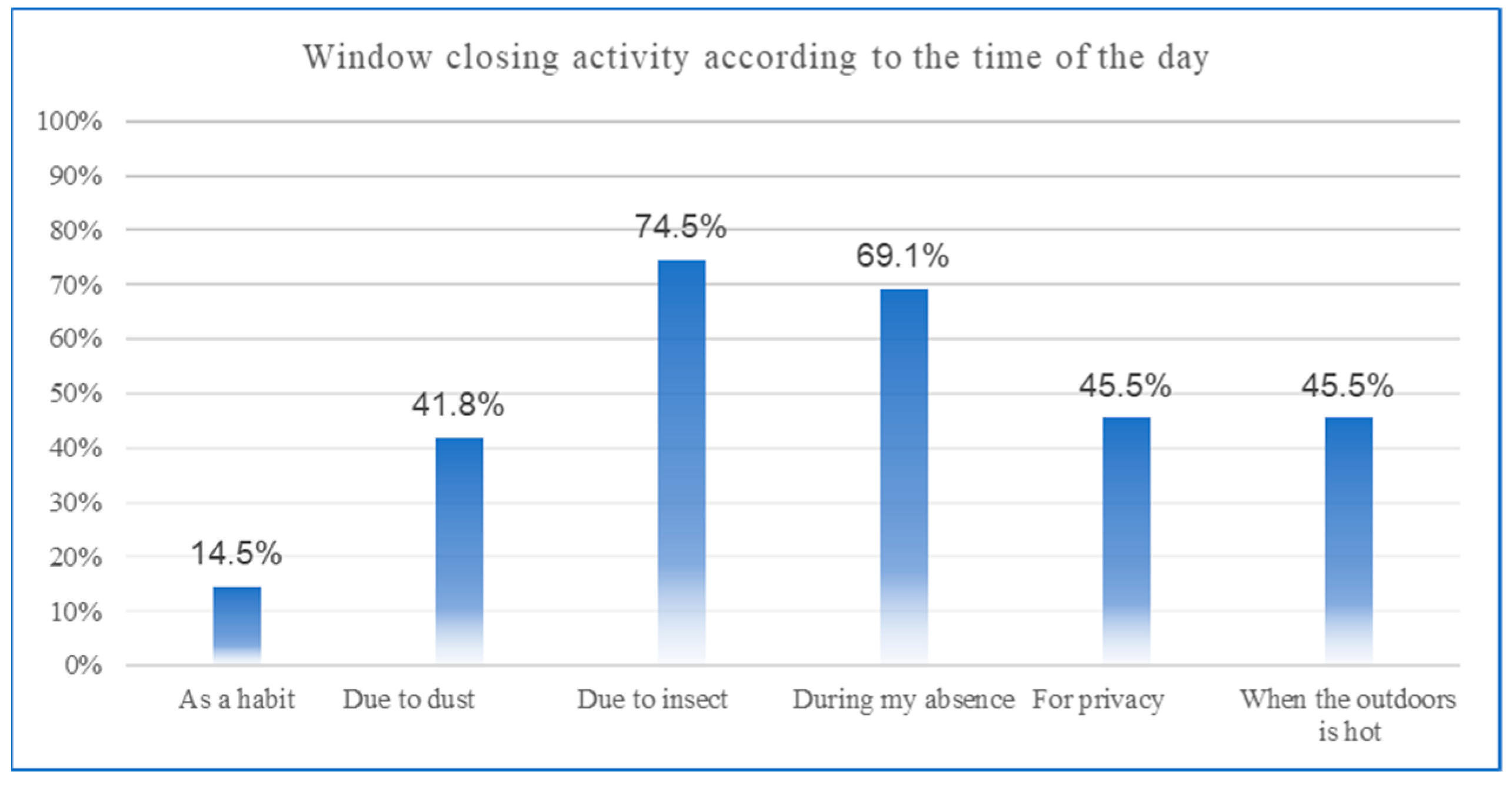

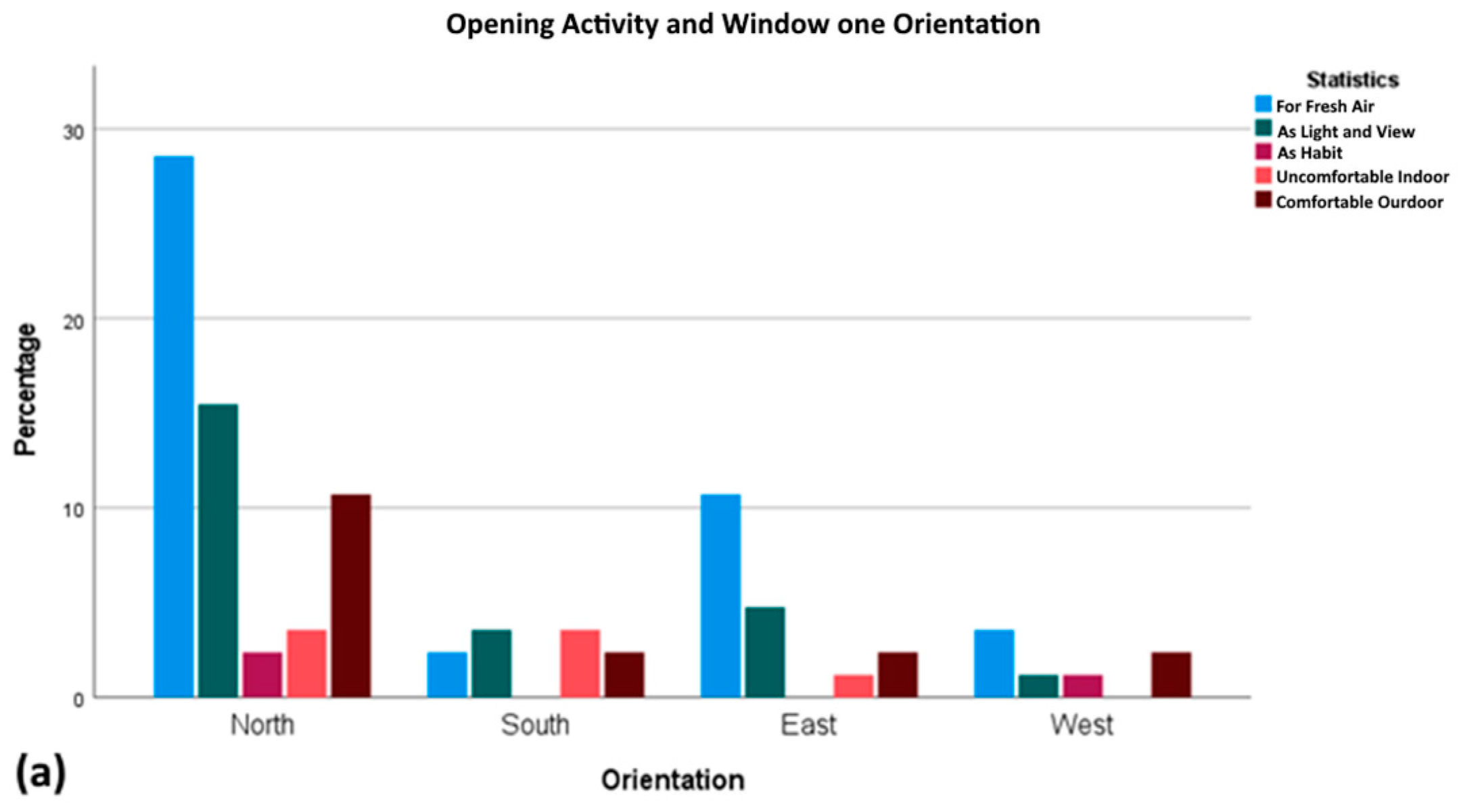
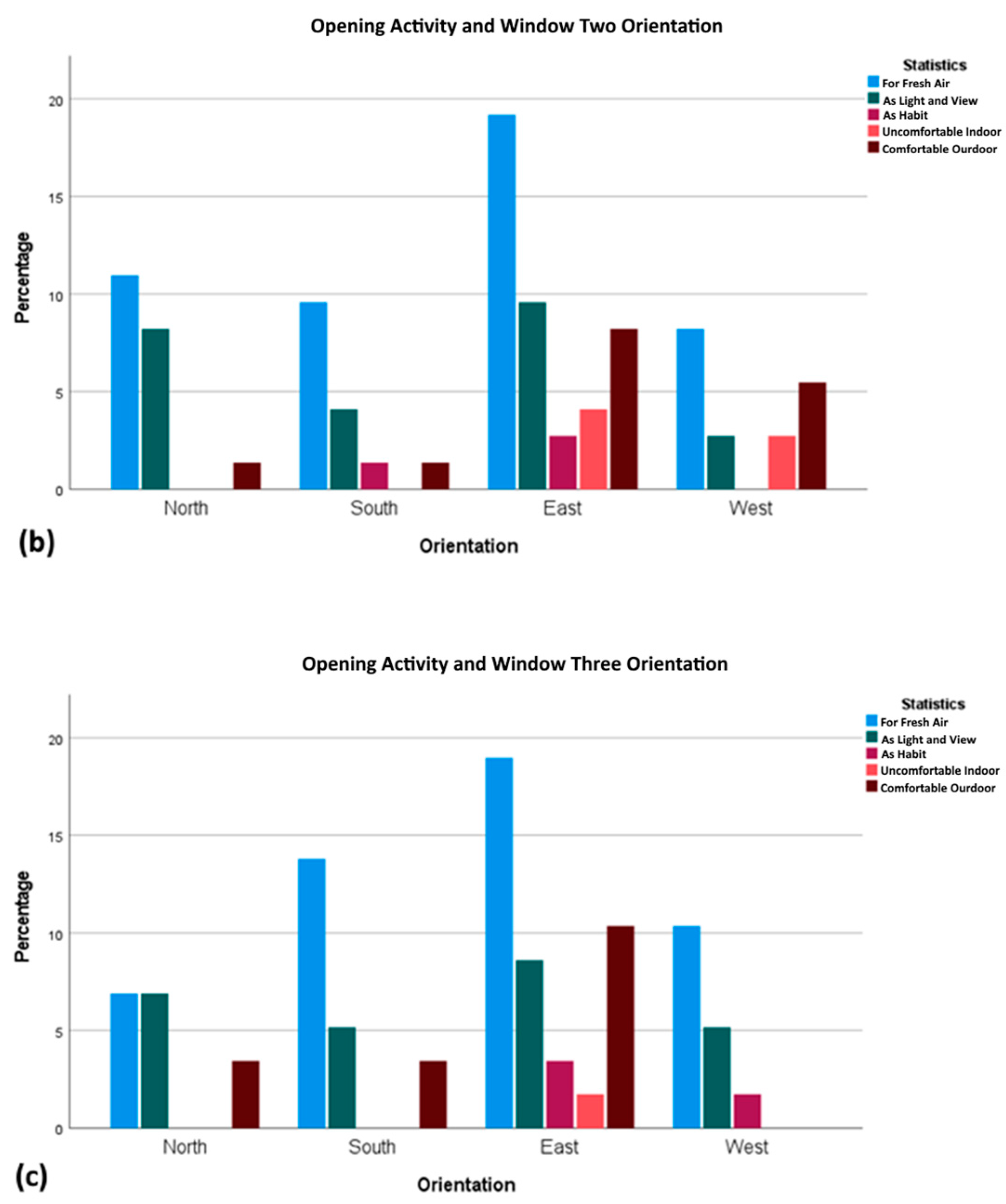
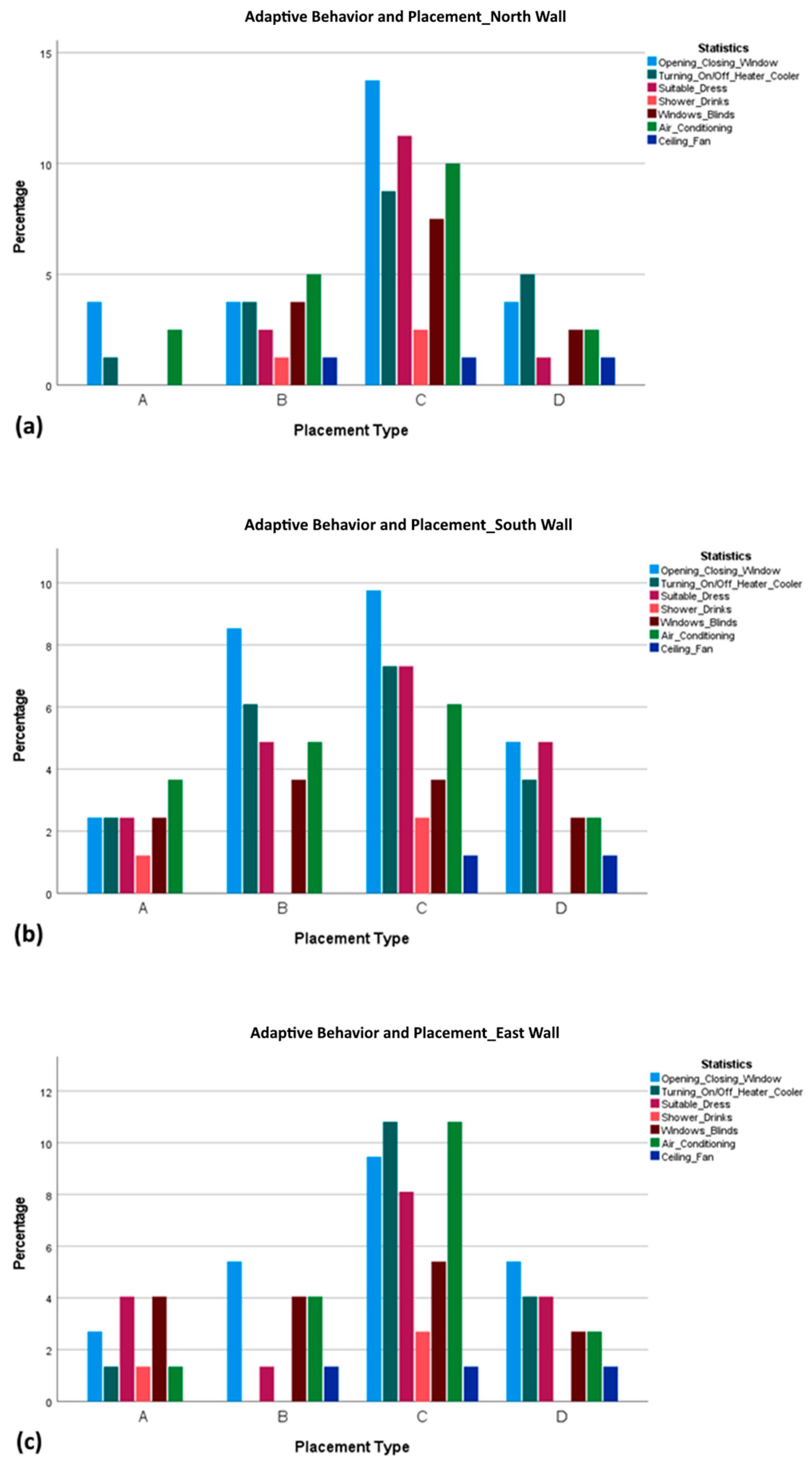
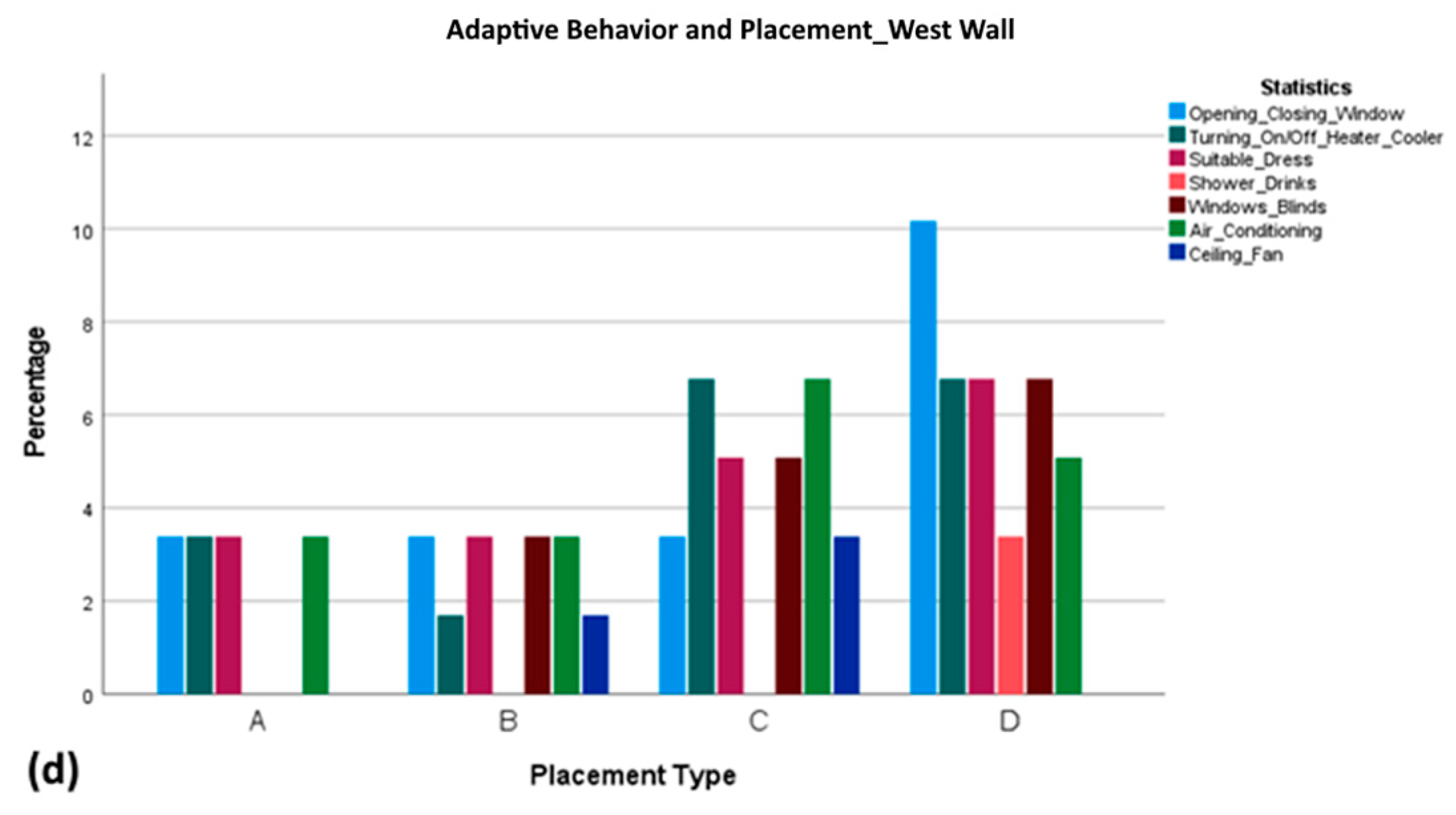


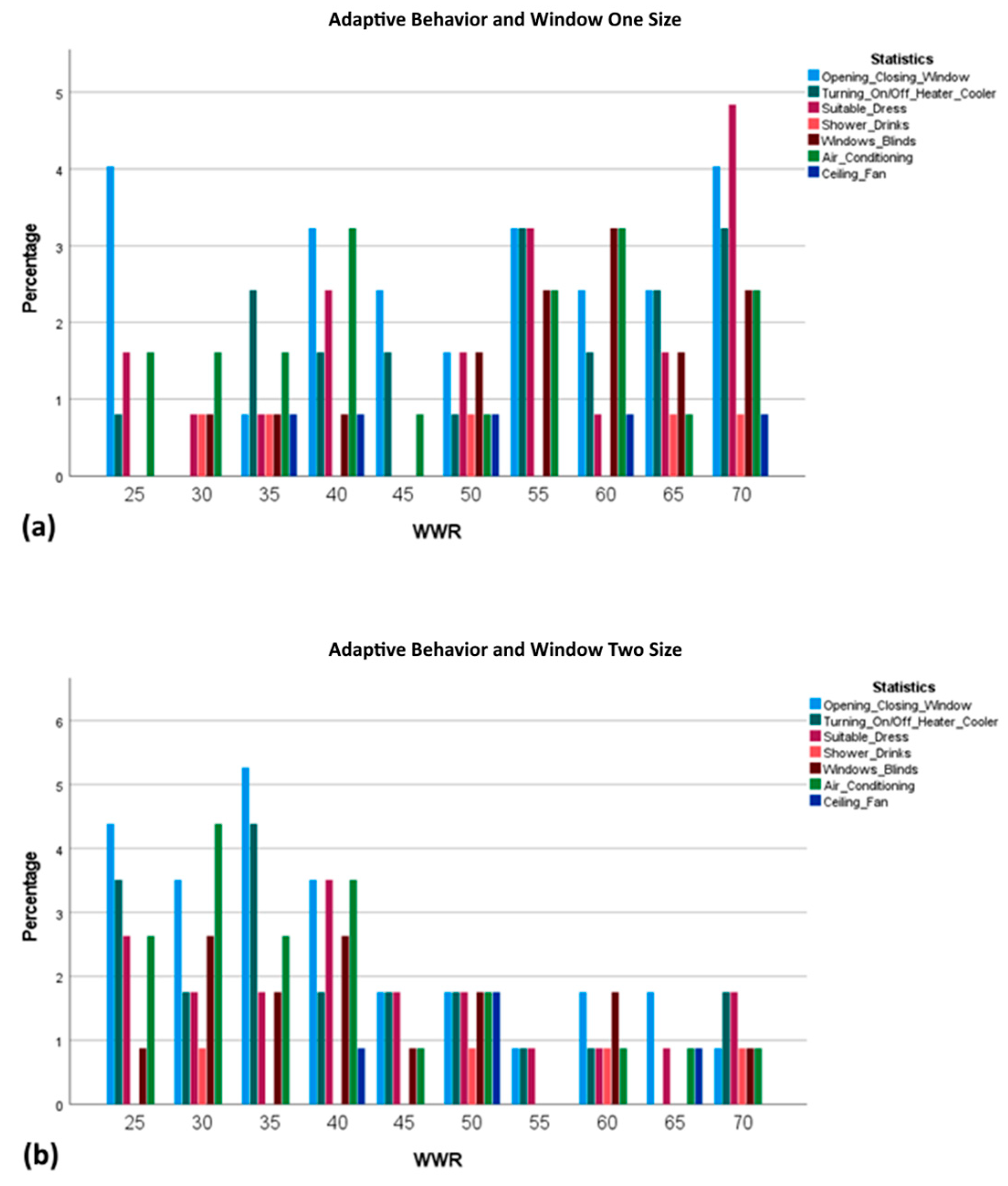


| Section | Subject of Questions | Reason | Related Questions |
|---|---|---|---|
| General Demographics and Building Features | Age group and gender | The relationship between the age and gender of users and their usage pattern. | 1, 2 in DF section |
| Postal code | Find the nearest weather station and roughly guess the financial status. | 1 in GBF section | |
| Type of building | This study only considers residential buildings. | 4 in GBF section | |
| Ownership status, including bill and annual income | Compare NV usage patterns based on ownership and financial level. Find the impact of the included electricity bill on the NV usage pattern. | 4, 6 in DF section, 13 in BA section | |
| Geometric Factors | Number of bedrooms and living room area | Enhanced understanding of the layouts and a comparison of the area of rooms and the living room. | 6, 7 in GBF section |
| Size and orientation of windows | Investigate the WWR and determine the relationship between wind direction and NV usage pattern. | 8 in GBF section | |
| Placement of windows (using picture) | Understand the relationship between NV usage patterns and placement. | 9 in GBF section | |
| Dimensions of the living room (ceiling height, length, and width) | Understand the layout dimensions and NV performance pattern due to the number of windows and usage pattern. | 2, 3 in GBF section | |
| Window and balcony options | Understand the residents’ preferences and deeply understand their behaviors. | 2, 3 in BA section | |
| Behavior and Awareness | Availability of ventilation options and preferences in NV devices | Understand whether the usage pattern is due to their behavior or to the current situation. Understand what factors affect their behavior. | 10, 11 in BA section and 1, 2, 3, 4 in VO section |
| Window operation model | Opening time of windows means more NV usage even if they open them for other reasons. | 5, 6, 12 in BA section | |
| Satisfaction level VS energy usage | Understand the occupant’s beliefs and compare them with their behavior. | 1 in BA section and 5 in DF section | |
| Feeling and Comfort | Feeling and sensation of comfort | Understand the level of comfort using different cooling scenarios and their real feeling in their house due to the current situation. | 1, 2 in TOC section and 1, 4, 7, 8, 14 in BA section |
| The main reason for opening or closing windows | The main reasons for residents opening/ closing windows and understanding their usage pattern regarding NV. | 5, 8, 9, 12 in BA section |
| No. | Questions | Reason |
|---|---|---|
| 1 | If you were to improve your house’s natural ventilation (save energy), which of the following solutions would you choose? | How would their NV preference affect any changes in their current situation? |
| 2 | In terms of natural ventilation, which one is your favorite? | The general view about NV preferences. |
| 3 | What is the most common adaptive behavior you use to make yourself comfortable? | Understanding the general adaptive behavior. |
| 4 | What is your preference? | Understanding the general preferences. |
| 5, 6 | Based on the time of day, you open and close your windows mostly for… (multi-choice accepted) | Understanding the time duration of using windows and background reasons. |
| 7, 8 | Which one do you have/prefer to have in your living room? | NV current situation/preferred situation. |
| 9, 10 | Which one best describes your window-opening/closing operation model? | What their opening/closing behaviors are and what factors affected their behaviors. |
| No. of Eligible Respondents (Target Residential Buildings) | Average Residence Area | Average Living Room Area | Window on North Wall | Window on East Wall | Window on West Wall | Window on South Wall |
|---|---|---|---|---|---|---|
| 83 (Out of 135) | 196.7 m2 | 33.5 m2 | 79% | 67% | 58% | 55% |
Disclaimer/Publisher’s Note: The statements, opinions and data contained in all publications are solely those of the individual author(s) and contributor(s) and not of MDPI and/or the editor(s). MDPI and/or the editor(s) disclaim responsibility for any injury to people or property resulting from any ideas, methods, instructions or products referred to in the content. |
© 2024 by the authors. Licensee MDPI, Basel, Switzerland. This article is an open access article distributed under the terms and conditions of the Creative Commons Attribution (CC BY) license (https://creativecommons.org/licenses/by/4.0/).
Share and Cite
Pourtangestani, M.; Izadyar, N.; Jamei, E.; Vrcelj, Z. Linking Occupant Behavior and Window Design through Post-Occupancy Evaluation: Enhancing Natural Ventilation and Indoor Air Quality. Buildings 2024, 14, 1638. https://doi.org/10.3390/buildings14061638
Pourtangestani M, Izadyar N, Jamei E, Vrcelj Z. Linking Occupant Behavior and Window Design through Post-Occupancy Evaluation: Enhancing Natural Ventilation and Indoor Air Quality. Buildings. 2024; 14(6):1638. https://doi.org/10.3390/buildings14061638
Chicago/Turabian StylePourtangestani, Mojgan, Nima Izadyar, Elmira Jamei, and Zora Vrcelj. 2024. "Linking Occupant Behavior and Window Design through Post-Occupancy Evaluation: Enhancing Natural Ventilation and Indoor Air Quality" Buildings 14, no. 6: 1638. https://doi.org/10.3390/buildings14061638
APA StylePourtangestani, M., Izadyar, N., Jamei, E., & Vrcelj, Z. (2024). Linking Occupant Behavior and Window Design through Post-Occupancy Evaluation: Enhancing Natural Ventilation and Indoor Air Quality. Buildings, 14(6), 1638. https://doi.org/10.3390/buildings14061638












